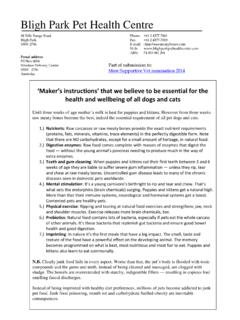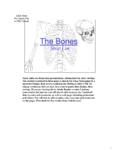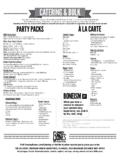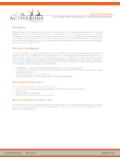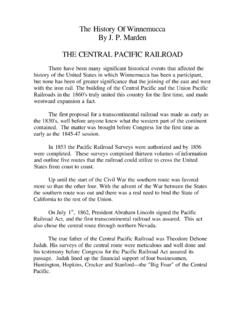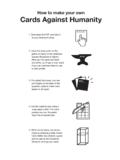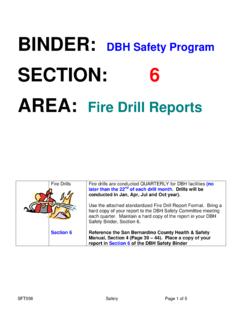Transcription of Tom Lonsdale Veterinary Surgeon - Raw Meaty Bones
1 Tom Lonsdale Veterinary Surgeon PO Box 6096 Phone: +61 2 4578-1389 Windsor Delivery Centre Fax: +61 2 4578-1384 NSW 2756 E-mail: Australia Web: January 2006 Diet guide for domestic dogs and cats Dingoes and feral cats keep themselves healthy by eating whole carcasses of prey animals.
2 Ideally we should feed our pets in the same manner. Until a dependable source of whole carcasses becomes available, pet owners need a satisfactory alternative. The following recommendations, based on raw Meaty Bones , have been adopted by thousands of pet owners with excellent results. The diet is easy to follow and cheap, and pets enjoy it. Fresh water constantly available. Raw Meaty Bones (or carcasses if available) should form the bulk of the diet. Table scraps both cooked and raw (grate or liquidise vegetables, discard cooked Bones ).
3 Puppies and kittens From about three weeks of age puppies and kittens start to take an interest in what their mother is eating. By six weeks of age they can eat chicken carcasses, rabbits and fish. During the brief interval between three and six weeks of age it is advisable to provide minced chicken, chicken carcasses or similar for young animals (as well as access to larger pieces that encourage ripping and tearing). This is akin to the part-digested food regurgitated by wild carnivore mothers.
4 Large litters will need more supplementary feeding than small litters. (The meat and bone should be minced together. Meat off the bone can be fed, but only for a short time, until the young animals can eat meat and bone together usually about six weeks of age.) Between four and six months of age puppies and kittens cut their permanent teeth and grow rapidly. At this time they need a plentiful supply of carcasses or raw Meaty Bones of suitable size. Puppies and kittens tend not to overeat natural food.
5 Food can be continuously available. Natural foods suitable for pet carnivores Raw Meaty Bones Chicken and turkey carcasses, after the meat has been removed for human consumption, are suitable for dogs and cats. Poultry by-products include: heads, feet, necks and wings. Whole fish and fish heads. Goat, sheep, calf, deer and kangaroo carcasses can be sawn into large pieces of meat and bone . Other by-products include: pigs trotters, pigs heads, sheep heads, brisket, tail Bones , rib Bones .
6 Whole carcasses Rats, mice, rabbits, fish, chickens, quail, hens. Offal Liver, lungs, trachea, hearts, omasums (stomach of ruminants), tripe. Quality Quantity Frequency Healthy animals living and breeding in the wild depend on the correct quality of food in the right quantity at a correct frequency. They thereby gain an appropriate nutrient intake plus the correct amount of teeth cleaning animals, unlike humans, brush and floss as they eat. Quality Low-fat game animals and fish and birds provide the best source of food for pet carnivores.
7 If using meat from farm animals (cattle, sheep and pigs) avoid excessive fat, or Bones that are too large to be eaten. 2 Dogs are more likely to break their teeth when eating large knuckle Bones and Bones sawn lengthwise than if eating meat and bone together. Raw food for cats should always be fresh. Dogs can consume ripe food and will sometimes bury Bones for later consumption. Quantity Establishing the quantity to feed pets is more an art than a science. Parents, when feeding a human family, manage this task without the aid of food consumption charts.
8 You can achieve the same good results for your pet by paying attention to activity levels, appetite and body condition. High activity and big appetite indicate a need for increased food, and vice versa. Body condition depends on a number of factors. The overall body shape is it athletic or rotund and the lustre of the hair coat provide clues. Use your finger tips to assess the elasticity of the skin. Does it have an elastic feel and move readily over the muscles? Do the muscles feel well toned? And how much coverage of the ribs do you detect?
9 This is the best place to check whether your pet is too thin or too fat. By comparing your own rib cage with that of your pet you can obtain a good idea of body condition both your own and that of your pet. An approximate food consumption guide, based on raw Meaty Bones , for the average pet cat or dog is 15 to 20 percent of body weight in one week or 2 to 3 percent per day. On that basis a 25 kilo dog requires up to five kilos of carcasses or raw Meaty Bones weekly. Cats weighing five kilos require about one kilo of chicken necks, fish, rabbit or similar each week.
10 Table scraps should be fed as an extra component of the diet. Please note that these figures are only a guide and relate to adult pets in a domestic environment. Pregnant or lactating females and growing puppies and kittens may need much more food than adult animals of similar body weight. Wherever possible, feed the meat and bone ration in one large piece requiring much ripping, tearing and gnawing. This makes for contented pets with clean teeth. Frequency Wild carnivores feed at irregular intervals.
